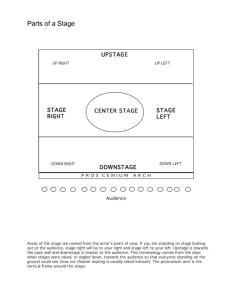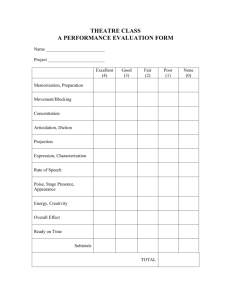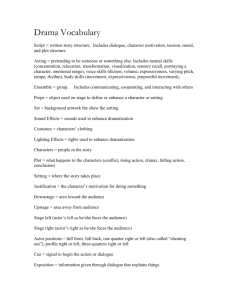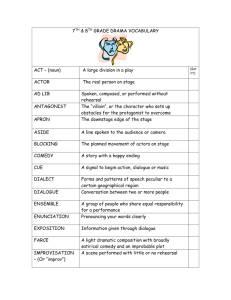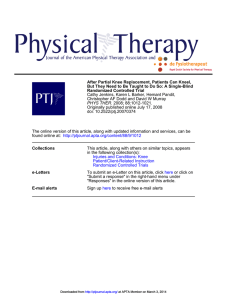Basic Stage Movement and Business - Parkway C-2
advertisement
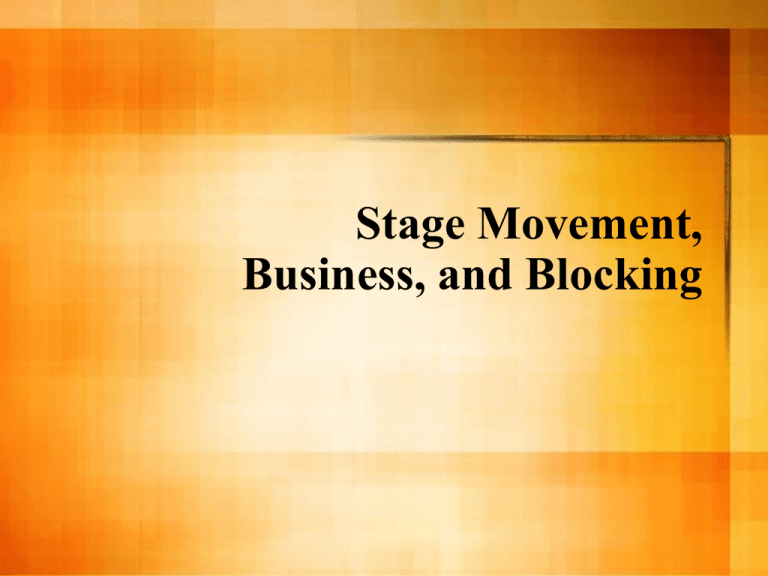
Stage Movement, Business, and Blocking Movement Review Objective: to look at movement technically, creatively, and with motivation, by using your bodies and movement to tell a story and encouraging the fact that not all stories need to be told with speaking. - Types of Stages - Areas of the Stage (SR, C, SL, etc.) - Body Positions - Types of Emphasis (Direct, Duo, etc.) - Levels, Diagonals, Planes Today: Enduring Understanding (EU) Movement expresses ideas and conveys messages to an audience. Essential Question (EQ) How can an artist reflect character through movement? Blocking vs. Business What is the difference between blocking and stage business? – Blocking is major actor movements -entrances, exits, a cross from the sofa to the fire place. (W.S. Gilbert) – Stage Business is small character defining movements. A character looking at his pocket watch, opening a book. Entrances (= Ent) Get into character BEFORE the entrance. Begin your entrance in the wings. At least 5 to 6 feet away. Focus in the Wings before you make your stage entrance. Exits (= Ex) Remain in character until you are 5-6 feet into the offstage area. If the exit requires a long cross, make sure the last few lines are spoken near the exit. Crosses (= X) Stage Crosses - movements from one stage area to another. Generally the actor takes the shortest, most direct route, which is a straight cross. – Straight crosses convey strength and determination (strong). – At times a curved cross is necessary to convey casualness, hesitation, or doubt (weak). Counter-Cross (= coX) To counter is to move from behind someone so one person will not be blocked by another. Actors adjust to each other’s cross by using a counter-cross. – A counter-cross is a movement in the opposite direction to balance stage picture Crossing on a Line If you are speaking and must cross the stage, walk in front of the other characters. – – It is generally best to avoid moving when another character is talking, as your movement you will steal attention from the speaking actor. If you need to cross when others are speaking, cross quietly behind them. The moving figure dominates! Turning (= ∞) Always turn toward the audience unless your director tells you otherwise. Backing Up (= ) This is a weak move and should be avoided unless the move backward makes a dramatic point. Sitting ( = S) Approach the piece of furniture without staring at it. Don’t telegraph the move. Stop in front of chair touch BOTH calves to the chair without moving it. Avoid plopping or slumping into an easy chair or sofa (unless your character would do so). Sit near the front edge of the chair to make rising easier. (= R) Avoid crossing your legs onstage. – Females sit with ankles crossed or one foot slightly in front of the other – males sit with legs slightly apart. Kneeling (= K) When kneeling with only one knee – the downstage knee should touch the floor, helping to keep an “open” position. When kneeling on both knees, – the downstage knee should be lowered first; then the upstage leg can be lowered into position. Stage Business Adding color to your movement Stage Business (SB) - What does it mean? Movement that an actor does to develop a full character. Most of time it is the actor who comes up with stage business not the director. Sometimes the playwright will also give SB 2 Types of Stage Business 1. Personal Business small actions performed by actors such as: – looking in a purse, – brushing one’s teeth, – tying a shoe, pouring a drink, – knitting, reading, writing, nail biting, etc. These actions are related to the character and his/her role in the scene. 2 Types of Stage Business 2. Gestures Avoid covering the face with a gesture. – When handling stage props such as a telephone or making large gestures, use the upstage hand. Remember that any movement can and will draw the audience’s attention. What Stage Business do you see in this picture? MARRIAGE BLANC by Tadeusz Rozewicz How about in this photo? And here? Here? What stage business could an actor add to this type of setting? Movement can tell a story all on its own.
